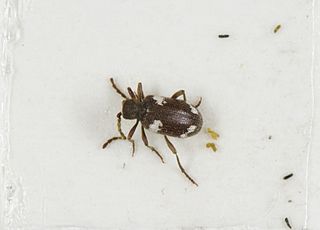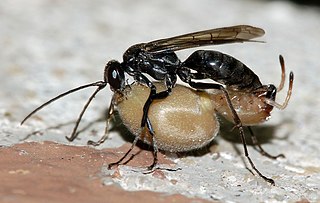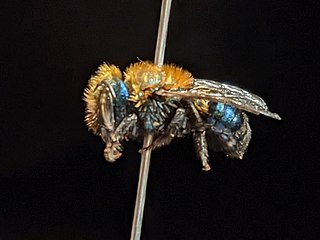
Entomology is the scientific study of insects, a branch of zoology. In the past the term insect was less specific, and historically the definition of entomology would also include the study of animals in other arthropod groups, such as arachnids, myriapods, and crustaceans. This wider meaning may still be encountered in informal use.

Pollination of fruit trees is required to produce seeds with surrounding fruit. It is the process of moving pollen from the anther to the stigma, either in the same flower or in another flower. Some tree species, including many fruit trees, do not produce fruit from self-pollination, so pollinizer trees are planted in orchards.

Megachilidae is a cosmopolitan family of mostly solitary bees. Characteristic traits of this family are the restriction of their pollen-carrying structure to the ventral surface of the abdomen, and their typically elongated labrum. Megachilid genera are most commonly known as mason bees and leafcutter bees, reflecting the materials from which they build their nest cells ; a few collect plant or animal hairs and fibers, and are called carder bees, while others use plant resins in nest construction and are correspondingly called resin bees. All species feed on nectar and pollen, but a few are kleptoparasites, feeding on pollen collected by other megachilid bees. Parasitic species do not possess scopae. The motion of Megachilidae in the reproductive structures of flowers is energetic and swimming-like; this agitation releases large amounts of pollen.

The Fauna of British India with long titles including The Fauna of British India, Including Ceylon and Burma, and The Fauna of British India Including the Remainder of the Oriental Region is a series of scientific books that was published by the British government in India and printed by Taylor and Francis of London. The series was started sometime in 1881 after a letter had been sent to the Secretary of State for India signed by Charles Darwin, Sir Joseph Dalton Hooker and other "eminent men of science" forwarded by P.L.Sclater to R.H. Hobart. W. T. Blanford was appointed editor and began work on the volume on mammals.

Mason bee is a name now commonly used for species of bees in the genus Osmia, of the family Megachilidae. Mason bees are named for their habit of using mud or other "masonry" products in constructing their nests, which are made in naturally occurring gaps such as between cracks in stones or other small dark cavities. When available, some species preferentially use hollow stems or holes in wood made by wood-boring insects.
Charles Lionel Augustus de Nicéville was a curator at the Indian Museum in Calcutta. He studied the butterflies of the Indian Subcontinent and wrote a three volume monograph on the butterflies of India, Bangladesh, Nepal, Burma and Sri Lanka. He also studied the mantids of the Oriental region.

Thomas Nelson Annandale CIE FRSE was a British zoologist, entomologist, anthropologist, and herpetologist. He was the founding director of the Zoological Survey of India.

Charles Thomas Bingham was an Irish military officer and entomologist.

Frederick Vincent Theobald FES was an English entomologist and "distinguished authority on mosquitoes". During his career, he was responsible for the economic zoology section of the Natural History Museum, London, vice-principal of the South-Eastern Agricultural College at Wye, Kent, Professor of Agricultural Zoology at London University, and advisory entomologist to the Board of Agriculture for the South-Eastern district of England. He wrote a five volume monograph and sixty scientific papers on mosquitoes. He was recognised for his work in entomology, tropical medicine, and sanitation; awards for his work include the Imperial Ottoman Order of Osmanieh, the Mary Kingsley Medal, and the Victoria Medal of Honour, as well as honorary fellowships of learned societies.

Osmia bicornis is a species of mason bee, and is known as the red mason bee due to its covering of dense gingery hair. It is a solitary bee that nests in holes or stems and is polylectic, meaning it forages pollen from various different flowering plants. These bees can be seen aggregating together and nests in preexisting hollows, choosing not to excavate their own. These bees are not aggressive; they will only sting if handled very roughly and are safe to be closely observed by children. Females only mate once, usually with closely related males. Further, females can determine the sex ratio of their offspring based on their body size, where larger females will invest more in diploid females eggs than small bees. These bees also have trichromatic colour vision and are important pollinators in agriculture.

Ptinus sexpunctatus is a species of beetles in the genus Ptinus of the family Ptinidae. It is commonly known as the six-spotted spider beetle.
Charles George Nurse FES was an English military officer, naturalist, ornithologist and entomologist. He was one of many British military officers who made significant contributions to knowledge of the natural history of India. Among his discoveries were a snake, a butterfly, an ant, and a neuropteran. About 50 species of moths that he collected were described by entomologists G. Hampson and Lord Walsingham. Entomologists P. Cameron and Col. C. T. Bingham described 200 species of Hymenoptera from his collections. Nurse also discovered the species of mosquito, Anopheles nursei, later shown to carry the malarial parasite that affected the army campaigns in Mesopotamia.

Grace Adelbert Sandhouse (1896–1940) was an American entomologist.

Auplopus is a large genus of spider wasps belonging to the subfamily Pepsinae of the spider wasp family Pompilidae, distributed throughout the world except for Antarctica. Auplopus wasps amputate the legs of their spider prey before transporting it to the nest.
Edward Yerbury Watson was an English entomologist who specialised in Lepidoptera most notably Hesperiidae.

Trevor Kincaid was a Canadian-American scientist and professor at the University of Washington who achieved national acclaim for his scientific achievements while an undergraduate student. Kincaid's interests ranged from insect life to marine biology to mollusks, though he once described himself as an "omniologist". He is best known for introducing the gypsy moth parasite to the United States, for helping establish the Washington state oyster industry, and as the driving force behind the creation of the Friday Harbor Laboratories. Kincaid is responsible for the identification and naming of hundreds of species; at least 47 plant and animal species were, in turn, named after him. In 1938 he was designated Alumnus Summa Laude Dignatus of the University of Washington, that school's highest honor for its alumni.

Osmia is a scientific journal published in English and French about Hymenoptera research, launched in 2007. It is published by the Observatoire des Abeilles [Observatory of Bees], a French and Belgian society about knowledge and protection of wild bees. The items are peer-reviewed and available online, in open access, under a free licence CC BY 4.0.

Osmia cerasi is a species of mason bee found in the southwestern United States and northern Mexico.
Osmia aeruginosa is a species of bee in the family Megachilidae and the genus Osmia. it is found in northern Fars province of iran













